|
|
|
The Land and Its People
|
Bangkok in 2000
Bangkok has no single, easily
identifiable centre. Instead, numerous
districts are centres in themselves.
each unified by common features
rooted either in ethnic character or a
specific function or business. Thus
Ratchadamnocn Avenue and its environs
remain the primary centre for government
ministries and international agencies,
while there is a major concentration of
commerce in Chinatown. Silom Road
has become the main banking and
financial disirict, and the Sukhumwit
Road area is predominantly a middleclass residential area.
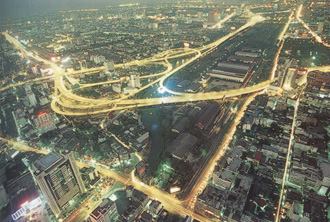
Elevated expressways lead trafffic through Bangkok
|
Outlying residential districts, meanwhile, continue to expand as more
housing estates and shopping complexes
are built to accommodate both the flow
of migrants converging on the capital
from upcountry and the new generation
of young married couples who are
increasingly leaving their parents'
homes for places of their own. Heavy
industry, too, is concentrated on the
outer fringes of the city, with industrial
parks springing up along major highways
leading out into the countryside. To facilitate communication between the
outer suburbs and downtown areas, an
elevated expressway system has been
built, as well as a ring road to allow
through traffic to bypass the city centre.
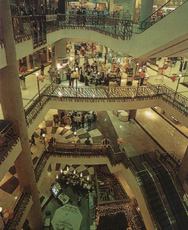 |
Western style shopping mall
|
Older Bangkok residents live in
separate, private houses, located either
in high-density neighbourhoods or,
increasingly rare, in relatively spacious
compounds in long-established areas like
Dusit and Bangkapi. Rising land values,
however, are producing new housing
concepts, especially in the more congested
inner city. Though Wesiem-style apartment
buildings and condominiums are
inhabited mostly by foreigners, more
and more Thais are moving into "town
houses." projects in which they own the
actual land and building but share a
common wall with their neighbors.
Hundreds of these projects have been
constructed in the city, some consisting
of several dozen units on a piece of land
thai once contained a single dwelling.
The biggest residential boom in the
early 1990s was in condominium construction. By the end of me decade, there
were more than 250 such projects,
mostly concentrated on Sukhumwit
and Rachadapisek Roads and along the
Chao Phraya River. Though the majority
of Thais are unfamiliar with the anonymity
of condominium life, many have been
forced into it by a desire to escape traffic
jams and be closer to their places of work.
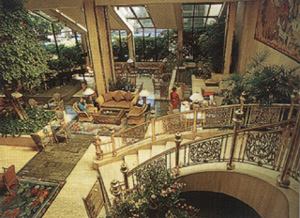
Luxury buildings dominate the city centre
|
Throughout Bangkok, lining main
roads and side streets, are innumerable
two, three, and four-storey shophouses
which contain specialty shops, restaurants, or small factories that are
generally family concerns. Workers and
family are commonly housed on the
upper floors. Such dwellings rarely have
recreational space or gardens, though
imaginative roof-lop plantings can be
glimpsed on some. Automobiles are
generally parked inside on the ground
floor and children play on the sidewalks outside.
Poorer people ofien live in singlestorey houses made of scrap lumber,
concentrated around the port area and
in certain suburbs. Government public
housing generally lakes the form of
low-rise blocks of simple flats located throughout the city.
The rapid growth of Bangkok has
severely strained its facilities and led to
a number of serious problems. The city
now has over a million registered
motor vehicles and because of the
limited road surface, traffic congestion
is heavy in central areas. Moreover, some
parts of the city are sinking due to the
pumping of water from artesian wells
to supply suburban projects and drainage
is inadequate in others; both have resulted
in periodic flooding during the rainy
season. Elaborate plans are being made
to relieve these problems. The first
section of an elevated system of rapid
public transport was opened at the end
of 1999 and an underground system
is being constructed; extensive floodcontrol projects are also underway.
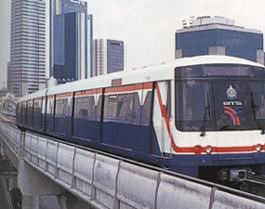
BTS mass transit system
|
Bangkok's population is predominantly young. Over half the residents
are under 30. Numerous new schools,
both public and private, have emerged
to meet the needs of this high concentration
of young people as well as two "open"
universities for those who cannot be
accommodated by the older institutions
of higher learning. The young also
influence the life of the capital in other
ways most of the city's shopping
centres are youth-oriented as are its
entertainment facilities.
The city's cultural life is greatly
enhanced by its minority communities.
Chinese and Indians account for nearly
10 percent of Ihe capital's population
and contribute to its variety of cuisines
and festivals, while Japanese and Asians
from neighbouring countries also figure
prominently in me city's cosmopolitan atmosphere.
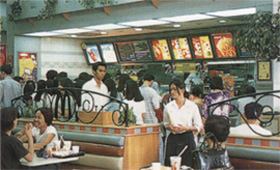
Fast food chains are growing more popular
|
Wesiem influence has also been
significant in creating a taste for new
fashions and new life-styles, as reflected
in such things as golf and tennis, delicatessens and boutiques, music and
drama, architecture and interior decoration. Fast foods from the West, too. like
hamburgers and pizzas, have become popular with young and old alike.
| | |
|
|